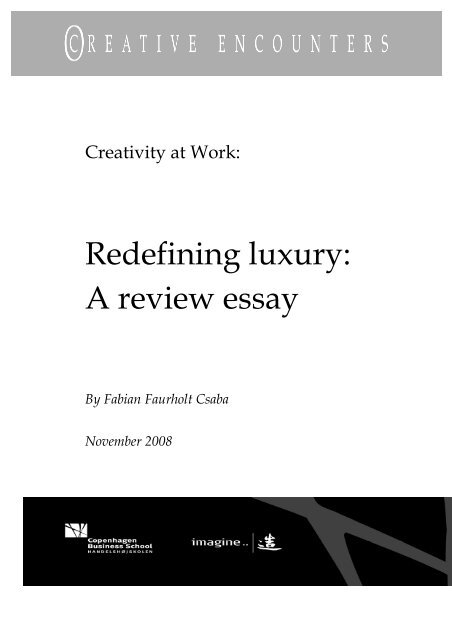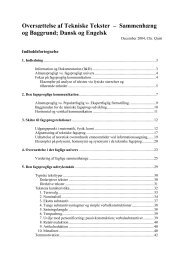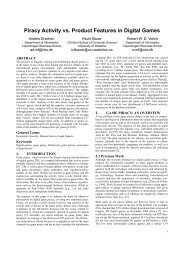Redefining luxury - OpenArchive@CBS - Copenhagen Business ...
Redefining luxury - OpenArchive@CBS - Copenhagen Business ...
Redefining luxury - OpenArchive@CBS - Copenhagen Business ...
You also want an ePaper? Increase the reach of your titles
YUMPU automatically turns print PDFs into web optimized ePapers that Google loves.
Creativity at Work:<br />
<strong>Redefining</strong> <strong>luxury</strong>:<br />
A review essay<br />
By Fabian Faurholt Csaba<br />
November 2008<br />
Page 1 of 32 Creative Encounters Working Papers #11
Abstract<br />
This paper seeks to establish a framework for the study of <strong>luxury</strong> based and to<br />
explore the contemporary <strong>luxury</strong> scene with the purpose of providing ideas<br />
and directions for more in-depth, focused investigations of the production and<br />
consumption of <strong>luxury</strong> goods. Drawing on sociological, anthropological and<br />
historical inquiry, it first addresses some of the key definitional, conceptual and<br />
moral issues arising in the analysis of <strong>luxury</strong>. Pointing to the challenges of even<br />
defining <strong>luxury</strong>, the paper adopts and extends a flexible scheme for<br />
conceptualizing <strong>luxury</strong>. This provides a framework for investigation the<br />
consumption and management of <strong>luxury</strong> today. We then examine<br />
contemporary <strong>luxury</strong> through different perspectives on “new <strong>luxury</strong>” and the<br />
related issue of Asia’s rise as the world’s primary market for <strong>luxury</strong>. While the<br />
paper does aim to give a sense of the characteristics of the present-day <strong>luxury</strong><br />
scene, the central focus of the study is on discourses on <strong>luxury</strong>. We consider to<br />
what extent and in which ways <strong>luxury</strong> is being redefined – by “new <strong>luxury</strong>”<br />
and Asia’s ascent. Finally the paper suggests themes and pointers for further<br />
research.<br />
Keywords<br />
Luxury, new <strong>luxury</strong>, <strong>luxury</strong> industry, branding, morality, hedonism,<br />
consumption<br />
Author<br />
Fabian Faurholt Csaba is Associate Professor in the Department of Intercultural<br />
Communication and Management at the <strong>Copenhagen</strong> <strong>Business</strong> School,<br />
Denmark. He may be reached by e-mail at fc.ikl@cbs.dk<br />
Page 2 of 32 Creative Encounters Working Paper # 15
Introduction<br />
This study first addresses some of the key definitional, conceptual and moral<br />
issues arising in the analysis of <strong>luxury</strong>. It points to the challenges of even<br />
defining <strong>luxury</strong>, and instead adopts and extends a flexible scheme for<br />
conceptualizing <strong>luxury</strong>. This provides a framework for investigation the<br />
consumption and management of <strong>luxury</strong> today. We then examine<br />
contemporary <strong>luxury</strong> through different perspectives on “new <strong>luxury</strong>” and the<br />
related issue of the rise of Asia as the world’s primary market for <strong>luxury</strong>. While<br />
the paper does aim to give a sense of the characteristics of the present-day<br />
<strong>luxury</strong> scene, the central focus of the study is on discourses on <strong>luxury</strong>. We<br />
consider to what extent and in which ways <strong>luxury</strong> is being redefined – by “new<br />
<strong>luxury</strong>” and Asia’s ascent. Finally the paper suggest themes and pointers for<br />
further research.<br />
Reframing <strong>luxury</strong>: Definitional and<br />
conceptual issues<br />
Where necessity ends<br />
One of the most fundamental issues in the study of <strong>luxury</strong> is the concept’s<br />
relationship to necessity. “Luxury is any expenditure that goes beyond the<br />
necessary”, as Werner Sombart begins his essay on the concept and nature of<br />
<strong>luxury</strong> (Sombart, 92). While the notion that <strong>luxury</strong> is essentially superfluous is a<br />
common one, it has been contested in scholarly debates. Two centuries before<br />
Sombart, Mandeville had tackled the definition of <strong>luxury</strong> against necessity in<br />
“The Fable of The Bees”, his controversial defense of <strong>luxury</strong> against prevailing<br />
moral views of the age. He proposed that in a strict sense, <strong>luxury</strong> is “every<br />
thing […] that is not immediately necessary to make Man subsist” (Mandeville,<br />
32) p.107. However, considering that all people, even “naked Savages”, over<br />
time have made improvements upon their former manner of living, for instance<br />
in preparation of food or dwellings, it is self-evident for Mandeville, that the<br />
interpretation is too rigorous. Very little, by this definition, is not <strong>luxury</strong>. The<br />
strict interpretation in other words needs to be relaxed. But Mandeville is<br />
reluctant to do so, because he finds it impossible to determine where necessity<br />
ends,<br />
[…]if once we depart from calling every thing Luxury that is not<br />
absolutely necessary to keep a Man alive, that then there is no Luxury<br />
at all; for if the wants of Men are innumerable, then what ought to<br />
supply them has no bounds; what is call’d superfluous to some degree<br />
of People, will be thought requisite to those of higher Quality; and<br />
Page 3 of 32 Creative Encounters Working Paper # 15
neither the World nor the Skill of Man can produce any thing so<br />
curious or extravagant, but some most Gracious Sovereign or other, if<br />
it either eases or diverts him, will reckon it among the Necessaries of<br />
Life; not meaning every Body’s Life, but that of his Sacred Person.<br />
(108)<br />
While Mandeville can be accused of deliberately complicating or even<br />
obfuscating the concept of <strong>luxury</strong> in challenging what he saw as prejudiced<br />
views, his arguments can be said to foreshadow contemporary critique<br />
naturalistic or essentialist notions of need and utility (Baudrillard 1993,<br />
Appadurai 1986). Such a position assumes human needs, at least primary<br />
needs, to be fundamental instincts or reflexes and hence ahistorical and<br />
acultural (Mortelmans, 05) 502. Mandeville’s inquiry provides other pointers for<br />
contemporary inquiry into <strong>luxury</strong> of which we shall note two.<br />
First, his work points to the relativity of <strong>luxury</strong>. Concepts of <strong>luxury</strong> vary<br />
from person to person, depending on their social position (and personal<br />
consumption experiences). Societies, of course, develop norms for what are<br />
considered luxuries and necessities, but these are fuzzy and vary over time and<br />
across classes and cultures. This relativity implies a basic indeterminacy of<br />
<strong>luxury</strong>, and suggests that we cannot ignore individuals’ notions and<br />
experiences of <strong>luxury</strong> or institutional efforts to define or fix what constitutes<br />
<strong>luxury</strong> in our considerations of the phenomenon. To compound the problem of<br />
pinning down what <strong>luxury</strong> means, the word is frequently used in a loose and<br />
clichéd manner in both everyday language and promotional discourse.<br />
Second, Mandeville’s polemic against prevailing moral values represents a<br />
significant moment in what Berry (Berry, 94) has called the “de-moralization of<br />
<strong>luxury</strong>”, a historical process of erosion – or, at least, transformation – of the<br />
censorious attitude towards <strong>luxury</strong> that had dominated Western throughout<br />
the pre-modern era. We shall return to both points later.<br />
In contrast to Mandeville, Sombart maintains that <strong>luxury</strong> can be<br />
meaningfully defined through its relationship to necessity, even if what is<br />
necessary is not fixed. Luxury is a “relational concept” (Relationsbegriff),<br />
whose content becomes intelligible when one knows what ‘the necessary’ is.<br />
What is deemed necessary differs “according to the climate of the historical<br />
epoch”, but can be determined either by subjective judgment (ethical,<br />
aesthetical or whatever kind) or measured against some kind of objective<br />
yardstick – a basic human physiological minimum (Notdurft) or what Sombart<br />
calls cultural necessity (Kulturnotdurft) (Sombart, 92), 85. Other than pointing<br />
to their arbitrary nature, he does not interrogate either further, but moves on to<br />
make further definitions to clarify his conceptualization of <strong>luxury</strong>. Figure 1<br />
illustrates the key components in Sombart’s understanding of <strong>luxury</strong>.<br />
Page 4 of 32 Creative Encounters Working Paper # 15
Figure 1: Sombart's concept of <strong>luxury</strong><br />
First, Sombart distinguishes between two senses of <strong>luxury</strong> – a quantitative<br />
and a qualitative. He associates <strong>luxury</strong> in the quantitative sense, with<br />
squandering, offering examples of having 100 waiters, when one can do the job;<br />
or using three matches to light a cigar. Luxury in the qualitative (and probably<br />
more common sense) means the use of better or more refined goods. Sombart<br />
defines refinement as all manufacture or preparation that exceeds basic<br />
purposefulness, and suggests that refinement can move in two directions, that<br />
of material and that of form or shape. Speaking in absolute terms, most<br />
consumer goods belong to the refined category, so we might think of <strong>luxury</strong> or<br />
fine goods in a narrower sense as being above average refinement. Qualitative<br />
and quantitative <strong>luxury</strong> can appear together and often do so.<br />
Observing that demand for finer goods serves vastly different purposes<br />
and has different origins, Sombart suggests another distinction, namely that<br />
between idealistic or altruistic <strong>luxury</strong> and materialistic, egoistic <strong>luxury</strong>. The<br />
former refers to expenditure on finer goods for public or ecclesiastical purposes,<br />
and he offers a gilded altar as an example. Sombart is preoccupied with and<br />
seeks to trace the origins of the latter, more personal form of <strong>luxury</strong>, which he<br />
argues increased greatly during the Renaissance. Invoking the silk shirt as an<br />
emblem, he claims that all personal <strong>luxury</strong> originates from the enjoyment of<br />
sensory pleasures. What arouses the eye, ear, nose, palate and sense of touch,<br />
becomes expressed ever more completely in consumer goods of different kind.<br />
For Sombart, all demand or desire for the increase and refinement of arousal of<br />
the senses (Sinnenreizmittel) can ultimately be traced to our sexual life. In his<br />
Page 5 of 32 Creative Encounters Working Paper # 15
analysis, sensual pleasure and the erotic are ultimately the same. So the impulse<br />
for the development of <strong>luxury</strong> can be traced to certain conscious or unconscious<br />
amorous sentiments or libidinal motives.<br />
As suggested, the reflections of Mandeville and Sombart address<br />
definitional and conceptual issues of great relevance even to contemporary<br />
analysis of <strong>luxury</strong>. And the terms, themes and problems set out in their<br />
inquiries have influenced recent sociological and historical investigations of<br />
<strong>luxury</strong>. In extending our framework for the study of <strong>luxury</strong>, I will take a closer<br />
look of two important contributions.<br />
In his introductory essay to “The Social Life of Things”, the influential<br />
anthology on commodities in a cultural perspective, Arjun Appadurai offers a<br />
concise conception of <strong>luxury</strong> (Appadurai, 86), which might provide anchoring<br />
and directions for our inquiry. The section of the essay on <strong>luxury</strong> reads as a<br />
strong endorsement of Sombart’s approach to the social history of capitalism<br />
with its focus on the role of consumption and demand as an alternative to<br />
dominant Marxist and Weberian views dealing mainly with the production<br />
side. But contrary to Sombart, Appadurai argues for a departure from the<br />
conception of <strong>luxury</strong> goods in contrast to necessities. He finds, echoing<br />
Mandeville, that the “needs” goods respond to are essentially political – they do<br />
not reflect any natural or universal human requirement. Instead, he proposes<br />
that <strong>luxury</strong> goods should be understood as “incarnated signs”, whose<br />
predominant functions are rhetorical and social. Appadurai proposes that any<br />
good may move into a “<strong>luxury</strong> register” and be consumed as a <strong>luxury</strong>. But<br />
certain commodities are exemplary of this class, and these can be called <strong>luxury</strong><br />
goods. He lists five characteristics of <strong>luxury</strong> (Appadurai, 86), 38:<br />
(1) Restriction to elites by law or price<br />
(2) Complexity of acquisition – which may or may not reflect<br />
real “scarcity”<br />
(3) Semiotic virtuosity<br />
(4) Codes for “appropriate” consumption demanding<br />
specialized knowledge<br />
(5) High degree of linkage of their consumption to body,<br />
person and personality<br />
Appadurai argues that some or all of the attributes must be present for<br />
something to be understood as a <strong>luxury</strong>, but otherwise offers limited<br />
explication and qualification of his scheme. This leaves it open to criticism, but<br />
also elaboration and extension.<br />
Page 6 of 32 Creative Encounters Working Paper # 15
Figure 2: Appadurai's <strong>luxury</strong> register<br />
First, we might ask whether any one of the five dimensions is required for<br />
a good to be classified as a <strong>luxury</strong>. Mortelmans (Mortelmans, 05) argues that<br />
“scarcity” is an essential component in the narrow definition employed by<br />
<strong>luxury</strong> industry institutions such as Comité Colbert to demarcate “their<br />
territory”. The two other markers of <strong>luxury</strong> in this definition, “extra value” and<br />
“high quality”, can be linked to (1) restriction to elites by price (to the extent<br />
that extra value translates into extra price) and (4) specialized knowledge,<br />
enabling the appreciation of “quality” and “value”. Mortelmans suggests that<br />
<strong>luxury</strong> institutions have a vested interest in guarding a narrow conception, and<br />
we must therefore interrogate motives behind conventional and restricted<br />
interpretations of <strong>luxury</strong>.<br />
Berry, as we shall see, argues that luxuries are closely tied to the body and<br />
sensory stimulation, suggesting that (5) is a required attribute. Rarity or any of<br />
the other attributes do not seem to be sufficient conditions for <strong>luxury</strong>.<br />
Are any of these attributes redundant or irrelevant then? We might ask<br />
whether semiotic virtuosity, i.e. the capacity for signaling fairly complex social<br />
messages, is distinctive trait of luxuries. It might be argued that if <strong>luxury</strong> goods<br />
are restricted to and signify elites, their expressive potential is narrowed down<br />
to the vertical dimension – i.e. they become status markers. Then we might ask,<br />
are luxuries restricted to elites, or does this represent an old-fashioned<br />
conception of <strong>luxury</strong>. The restriction of goods to elites by law, at least harks<br />
back to sumptuary laws that were repealed centuries ago. Berg (Berg, 07)<br />
Page 7 of 32 Creative Encounters Working Paper # 15
suggests that luxuries might just as well associated with festive expenditures<br />
and indulgences of non-elites. Finally, we might ask whether codes of<br />
appropriate consumption and associated special knowledge are regulated<br />
solely by fashion, as Appadurai implies, or whether they reflect education and<br />
cultural capital.<br />
Despite these reservations, or, perhaps, because of its open-ended nature,<br />
Appadurai’s framework provides a useful foundation for reflecting upon the<br />
nature and properties of <strong>luxury</strong>. While Appadurai’s reflections on <strong>luxury</strong><br />
represent only a brief section in a broader essay on commodities, exchange and<br />
value, Christopher Berry (Berry, 94) provides one of the most comprehensive<br />
recent investigations of the concept of <strong>luxury</strong>, particularly its intellectual<br />
history. Later, we shall draw more extensively on his work as a source for<br />
tracing the moral problematization of <strong>luxury</strong> in Western thought. But it is worth<br />
considering some of Berry’s arguments regarding the conceptualization of<br />
<strong>luxury</strong>. Berry acknowledges the problems of identifying <strong>luxury</strong> with what is<br />
not necessary or useful, but is unlike Appadurai not ready to do away with the<br />
language of needs in exploring the meaning of <strong>luxury</strong>. “It is important in a<br />
consideration of <strong>luxury</strong> not to identify it with redundancy or uselessness”, he<br />
suggests (Berry, 94), 40, but maintains that <strong>luxury</strong> goods can be “defined<br />
negatively by their not being goods that are deemed socially necessary; nor<br />
utilitarian instruments, necessary means to an end; nor objects of fervent desire;<br />
nor cherished possessions”. Berry is well aware of the problems of establishing<br />
what “needs” and “necessities” are in any strict sense. But thinking of needs in<br />
contrast to wants and desires in each end of a continuum, enables him to<br />
analyze the complicated ways <strong>luxury</strong>, desires and (more or less socially<br />
constructed) needs are related.<br />
Page 8 of 32 Creative Encounters Working Paper # 15
Figure 3: Berry's conceptual frame<br />
Luxury goods are primarily associated with desires and wants. But since<br />
desires build on human needs, which they specify and particularize, luxuries<br />
are indirectly connected to basic needs, the body and sensory experience. But<br />
since they do not merely remove pain or meet bare necessities, but gratify the<br />
senses, luxuries are “positively pleasing” and widely desired. The link also<br />
leads Berry to suggest that <strong>luxury</strong> falls into four categories reflecting to basic<br />
universal needs for shelter, sustenance, clothing and leisure. While the<br />
categories can be stretched far, they do suggest a bodily and material anchoring<br />
of <strong>luxury</strong> (which is not as pronounced in Appadurai’s <strong>luxury</strong> register).<br />
Berry distinction of needs and desires is complicated by notions of<br />
instrumental needs, political needs and social necessities, which confuse terms<br />
of and distinctions between desires and needs and point the need to tread<br />
carefully in analyzing <strong>luxury</strong> along these lines. Instrumental needs are<br />
volitional and purposive, while (basic) needs are non-intentional. We might<br />
thus need something to ultimately obtain a desired object. A political need<br />
refers to something that is instrumental to maintaining a position in society, for<br />
instance appropriate (luxurious) attire or standards of hospitality. Social<br />
necessities are similar to Sombart’s notion of cultural necessity. They refer to<br />
possessions or levels of material comfort deemed necessary to maintain a<br />
minimum standard of decency or dignity in a given society at a given time. The<br />
luxuries of one era or society may be necessities in others.<br />
It is clear from Berry’s model that <strong>luxury</strong> is something dynamic, a subject<br />
to constant redefinition. Desires drive a continual refinement of goods and<br />
Page 9 of 32 Creative Encounters Working Paper # 15
experiences. As luxuries become commonplace, they are reclassified to social<br />
necessities. Berry refers to the “transience of <strong>luxury</strong>”. There are constraints on<br />
this process. Berry notes that needs are an important element in moralistic<br />
discourse, and in the course of history, <strong>luxury</strong> has been subject to criticism and<br />
regulation. In the following section, we turn the moral aspects of <strong>luxury</strong>.<br />
The moral problematization of <strong>luxury</strong><br />
From the first literate societies until high modernity the figure of Luxury has<br />
excited moral condemnation and stimulated the regulatory reflex. The moralization of<br />
<strong>luxury</strong> has exhibited remarkable persistence. The invocation of <strong>luxury</strong> is one of the most<br />
ancient and most pervasive negative principles around and through which social<br />
criticism and regulatory activity has been articulated. (Hunt 1995, 353)<br />
Why address moral discourses on <strong>luxury</strong>?<br />
This section takes a closer look at the moral discourses that have accompanied<br />
<strong>luxury</strong> from the earliest human societies. In recent years a considerable number<br />
of studies have addressed the moral problematization of <strong>luxury</strong>, and provide us<br />
with a fairly comprehensive picture of the dominant attitudes towards the<br />
consumption of <strong>luxury</strong> in Western thought of various historical eras. While<br />
studies generally agree on the main lines of critique in the pre-modern era and<br />
the fact that the condemnations lost their force during the 18 th century, some<br />
disagreement exists on the extent and significance of negative attitudes towards<br />
<strong>luxury</strong> in contemporary debates.<br />
If, as some claim, the moral problematization of <strong>luxury</strong>, if not ceased, then<br />
abated, more than two centuries ago, what is the point of dwelling on the<br />
censorious attitudes of the past.<br />
First, I would suggest that even if the critique has relaxed, the process of<br />
de-moralization was at best incomplete. Moral condemnation of <strong>luxury</strong> persists<br />
and has a certain influence contemporary discourse and public policy. I will<br />
also argue that while indictments of <strong>luxury</strong> are less visible in public debates<br />
than previously, because they have been subsumed under broader debates of<br />
the morality of consumption. Veblen’s Theory of the Leisure Class, which has<br />
been paradigmatic for sociological critique of consumption in the 20 th century,<br />
only mentions “<strong>luxury</strong>” a couple of times. But evidently, the work is linked to<br />
an older tradition for moral critique of <strong>luxury</strong>, and its influence on<br />
contemporary thought on <strong>luxury</strong> is beyond doubt.<br />
Miller (2001) castigates recent studies for being locked in a pre-established<br />
moral position that prevents them from investigating the complex and<br />
contradictory nature of consumption experiences. Instead they make facile<br />
identifications of consumption with materialism, capitalism and<br />
Americanization. Our investigation would suffer if we failed to at least reflect<br />
Page 10 of 32 Creative Encounters Working Paper # 15
upon tacit conceptions and norms regarding <strong>luxury</strong> that might affect our<br />
analyses or those we draw upon.<br />
On the other hand, much of the recent literature relevant to the study of<br />
<strong>luxury</strong> suffers from the opposite, a conspicuous absence of considerations of<br />
moral dimensions of <strong>luxury</strong>. Consumption – <strong>luxury</strong> consumption in particular –<br />
inevitably raises moral issues about freedom, justice and the common good in<br />
every culture (Wilk). This certainly includes relations and conditions under<br />
which <strong>luxury</strong> goods are produced. Any analysis either ignoring such issues or<br />
failing to reflect upon the moral schemes, we project onto <strong>luxury</strong>, is, I would<br />
argue, incomplete and deficient.<br />
Luxury in the history of Western thought<br />
Berry (Berry, 94)traces the moral problematization of <strong>luxury</strong> in the history of<br />
Western thought from the Ancient Greece to our age. He documents that <strong>luxury</strong><br />
was subject to deep moral concern and carried mainly negative connotations at<br />
least up until the seventeenth century.<br />
In Classical Greek thought, luxurious living was a concern because it was<br />
believed to be unhealthy, foster effeminacy, corrupt individual and society, and<br />
threaten the very existence of the polis. Men who lived a life of <strong>luxury</strong> were<br />
thought to become soft and emasculated, which made them incapable as<br />
warriors, undermining the polis’ ability to defend itself and its interests.<br />
Furthermore, <strong>luxury</strong> was seen to incite maleficent desires which took society<br />
beyond the concern for need satisfaction. Unlike needs, desires were boundless<br />
and insatiable; they led to invidious comparison, envy and dispute, and<br />
therefore had to be kept in check. Greek philosophers, such as Plato, saw <strong>luxury</strong><br />
as a threat to the social order, subject to measures of control and moderation.<br />
The Romans adopted key ideas and assumptions on <strong>luxury</strong> from the<br />
Greek, but added issues of their own and went further in institutionalizing<br />
means for regulating it. Luxury was a preoccupation of both Roman moralists<br />
and legislators. Their discussions of virtue and corruption emerged in response<br />
to Rome’s perceived decadence, and lead to the first sumptuary laws. Examples<br />
included the regulation of women’s dress (no colored robes) and possession of<br />
gold (Lex Oppia) and expenditures on feast days (Lex Fannia) limiting the<br />
number of non-family guests and the values of the silverware as well as<br />
banning foreign wine 1 (Berry, 94). Luxury was seen to undermine both civic<br />
virtue and a proper ordering of ranks. It represented the use of wealth to serve<br />
private satisfactions, rather than expenditure of ’surplus’ for public good.<br />
Private <strong>luxury</strong> reflected and induced self-indulgence, the emasculation of<br />
virtus, greed (avaritia) and ambition (which undermined proper hierarchy).<br />
1 Here we find an early example of concerns about the effects of foreign luxuries on the<br />
domestic economy and subsequent protectionist measures.<br />
Page 11 of 32 Creative Encounters Working Paper # 15
An important reference point in Roman thought on needs and <strong>luxury</strong> was<br />
the Stoic’s idealized notion of “natural life”, where human bodily needs, which<br />
are few and simple, are met but otherwise kept in place. Notions of a simple,<br />
natural life became a “normative benchmark against which unnatural, unfree or<br />
corrupt lives could be assessed” (Berry, 94). According to Berry, Roman<br />
debates on and regulation of <strong>luxury</strong> illustrate that efforts to establish and fix the<br />
boundary for what is ‘natural’ are tricky, arbitrary, and, of course, political.<br />
Early Christian thought retained the earlier connections between <strong>luxury</strong><br />
and corruption and other elements from of Greek and Roman thought suitable<br />
for its agenda. Concepts of necessity or natural order, against which <strong>luxury</strong> was<br />
a violation, were backed up by divine authority. Vice became sin, as <strong>luxury</strong> was<br />
identified with lechery, in opposition to sobriety and chastity. The connection of<br />
<strong>luxury</strong> to femininity (with its misogynist undercurrent) found in Greek and<br />
Roman ideas about emasculating ”softness”, indulgence and lack of selfcontrol,<br />
was extended through links to Christian mythology (Eve’s temptation<br />
of Adam) and norms concerning sexuality and marriage. Later, the pride and<br />
envy came in focus as sins induced by <strong>luxury</strong>. Hunts argues for theological<br />
differences in the way Catholicism and Protestantism treat <strong>luxury</strong>. Broadly<br />
speaking, Catholicism condemned <strong>luxury</strong> as a personal sin of pride, whereas<br />
Protestantism was more concerned with the immorality and dissoluteness.<br />
Puritanism castigated <strong>luxury</strong> for wasting resources that would otherwise be<br />
available for charitable works, echoing perhaps the juxtaposition of the<br />
harmfulness of <strong>luxury</strong> to the rich and concern for the plight of the poor found in<br />
the New Testament.<br />
During the 17 th and 18 th centuries, debates over <strong>luxury</strong> intensified and<br />
flowed back and forth. Advocates of commerce, such as Barbon and Mandeville<br />
stirred controversially by suggested that luxuries, however sinful, are beneficial<br />
for the wealth of nations. Over time figures such as Hume and Adam Smith<br />
contributed shifts in the evaluation of <strong>luxury</strong> that all but overturned the old<br />
tradition that had seen <strong>luxury</strong> as a threat to the social order and public good.<br />
Hume for instance linked refinement, <strong>luxury</strong> and civilization, and Adam Smith<br />
concluded that all things considered ‘opulent and civilized’ nations were<br />
superior to ‘poor and barbarous’. And where earlier moralists had evoked<br />
natural order and life in their polemics against luxuries, liberal thinkers now<br />
argued that aspirations to a life of <strong>luxury</strong> were natural. The debates over<br />
<strong>luxury</strong> gradually settled as Adam Smith argument that “individual greed and<br />
acquisitiveness were necessary prerequisites for the stimulation of the<br />
economy” gained currency, and human well-being came to be conceived in<br />
terms of economics, rather than a moral or religious basis (Hilton p. 102).<br />
Berry’s notion of the “de-moralization of <strong>luxury</strong>” refers to this shift.<br />
An important part of the explanation for the changing attitudes in the 18th<br />
century was that <strong>luxury</strong> itself was being transformed. Maxine Berg (2007)<br />
argues that a new, more widely accessible form of <strong>luxury</strong> had emerged, one<br />
Page 12 of 32 Creative Encounters Working Paper # 15
that was not to the same extent as old <strong>luxury</strong> susceptible to traditional lines of<br />
moral critique.<br />
Berg analyses how Western markets for new domestic and decorative<br />
objects developed in response to the exotic <strong>luxury</strong> goods – such as fine textiles,<br />
china and lacquered furniture – that were imported in unprecedented<br />
quantities by European East India companies by the 17th and 18th century. Asia<br />
of course had been the source of early exotic luxuries in Europe such as spices,<br />
scents, tea and silk. By the late 17 th century, Asian manufactures could produce<br />
craft objects offering quality and delight in such quantity and variety, that it<br />
represented a whole new category of <strong>luxury</strong> and stimulated new ways of<br />
thinking about household possessions and ornament. It opened the possibility<br />
for a higher, more civilized way of life for the broad segments of the<br />
population.<br />
Eventually the access to these goods, also led to European strategies for<br />
matching Asia <strong>luxury</strong> production. British manufacturers so successful in<br />
‘imitating’ Asian luxuries – absorbing certain principles, adapting others and<br />
developing their own – that English ‘modern <strong>luxury</strong>’ rose to prominence in<br />
world markets during the second half of the 18th century. According to Berg,<br />
the new <strong>luxury</strong> and semi-<strong>luxury</strong> items that emerged reflected an ‘economy of<br />
quality and delight’. They were not associated with the excess and ostentation<br />
of older elite consumption, nor foreign imports thought to harm the domestic<br />
economy; but expressed civility, comfort, fashion, taste and moderation. They<br />
appealed primarily to the urban middling classes of Britain, but engendered<br />
changes in material culture that also affected the laboring poor and wealthy<br />
elites, and gradually swept through continental Europe and markets beyond.<br />
Much of the stigma that had previously been attached to luxuries, did not<br />
apply to new consumer goods such as tea sets, glassware, tableware, brass and<br />
silver candelabra, boxes, cabinets etc. In the analysis of policy-makers, Berg (p.<br />
19) concludes, the economic advantages of a “more broadly based consumption<br />
of superfluities”, especially as new consumer goods were increasing produced<br />
at home, outweighed moralists’ lingering “concerns about social dislocation<br />
and moral corruption attendant on <strong>luxury</strong> consumption”.<br />
As argued, the process of de-moralization does not mean that moral<br />
concerns about <strong>luxury</strong> cease. The case can be made, according to Hunt (Hunt,<br />
95), that the critique of <strong>luxury</strong> has carried its conventional and moral force well<br />
into the 20 th Century. Hilton argues that the 18 th century <strong>luxury</strong> debates have<br />
left a legacy over the past two centuries, which suggests its issues were not<br />
entirely settled at the time. Furthermore he suggests a trend towards the remoralization<br />
of consumption and markets taking place. However, subsequent<br />
streams of problematization and critique seem to address <strong>luxury</strong> less directly;<br />
instead they have been subsumed under moralization of consumption more<br />
broadly. This can perhaps be attributed to the indeterminacy and transcience of<br />
<strong>luxury</strong>. In a consumer society, the boundaries between luxuries and nonluxuries<br />
are blurred and in constant flux.<br />
Page 13 of 32 Creative Encounters Working Paper # 15
In a critical review, Wilk (2001) traces three main currents in the social<br />
sciences addressing consumption in moral terms. The first, Veblen’s sociological<br />
approach, posits that consumption is motivated by social competition and<br />
emulation. It regards (conspicuous) consumption as wasteful, and reflective of<br />
false and shallow values. The implication of Veblen’s thought, for Wilk, is that<br />
fashion and modern material goods become empty and arbitrary, without<br />
meaning and content. This, and the fact that it fails to offer criteria for deciding<br />
what is productive and authentic and is wasteful and fake, makes this line of<br />
moral critique untenable, according to Wilk (p. 247). The second moral critique<br />
of consumption is psychological. It regards people’s desire for goods as a failed<br />
attempt to cope with the pressures of modern life and its repression of<br />
individual creative energies and sexual desires. Modern consumption reflects<br />
an excessive fixation on objects or investment of meanings in them as<br />
substitutes for real human relations. This approach informs two otherwise<br />
different strands of thought: a conservative critique of mass culture and a more<br />
liberal analysis of the commodity self. The third approach derives from Marx’s<br />
critique of modern capitalism. The capitalist mode of production means that all<br />
aspects of life become commoditized, causing profound sense of alienation.<br />
Consumption is motivated by people’s desire to recover a sense of unity and<br />
human wholeness, which consumer goods of course cannot provide. For Wilk,<br />
the overarching problem of the Marxist position is that it forecloses<br />
considerations of consumers’ accounts for their own consumption, which per<br />
definition reflect false consciousness and commodity fetishism. Berry points<br />
out that socialist critique indicts capitalism for supporting the ability to acquire<br />
<strong>luxury</strong>, ahead of the moral obligation of ensuring that needs are met (p. 19). The<br />
lack of a fixed concept of need would appear to undermine this line of<br />
argumentation; however the recourse to need retains its force and popularity in<br />
social criticism by reframing need. Needs thus refer to ‘relative’ rather than<br />
‘absolute’ poverty and become defined as the requirements to participate<br />
effectively in or retain autonomy in society (Berry, p. 21).<br />
While it seems obvious that both the critical approaches to consumption<br />
linked to Marx and Veblen applies to <strong>luxury</strong>, the conservative strand of the<br />
psychological critique of consumption is directed at mass production and<br />
consumption. Luxury consumption, to the extent that we are dealing with craft<br />
products which are out reach of the mass, escapes critique and might even be<br />
idealized.<br />
An example of contemporary criticism of <strong>luxury</strong>, that invokes themes<br />
found in older moral discourses as well as more recent currents of critique of<br />
consumption, is Robert Franks’ (2001) Luxury Fever: Why Money Fails to<br />
Satisfy in an Era of Excess. Franks’ work addresses the detrimental social,<br />
economical and environmental impact of growing inequality and escalating<br />
<strong>luxury</strong> consumption in the U.S. in recent decades, and prescribes progressive<br />
consumption tax is the only rational cure for this ’<strong>luxury</strong> fever’. He finds that<br />
the trickle-down economics that emerged with Reagan and more or less still<br />
holds sway, has created ”pockets of wealth to match even the most florid ones<br />
Page 14 of 32 Creative Encounters Working Paper # 15
of the Gilded Age” (p. 15). The parallels between the contemporary era and the<br />
Gilded Age, in Frank’s view, suggests that Veblen’s analysis of conspicuous<br />
consumption – which of course emerged in response to the excesses of late 19th<br />
century America – must be revived and updated. But we also find echoes of the<br />
Marxist approach to consumption: ”At a time when many truly pressing needs<br />
remain unmet”, Franks writes refering to investments in the refinements of<br />
<strong>luxury</strong> sports vehicles and watches rather than, for instance, health care , ”we<br />
must question the wisdom of spending millions of dollars to reduce zero-tosixty<br />
acceleration times by another few tenths of a second, or to refine<br />
mechanical devices, that will further attenuate the already negligible effect of<br />
gravity on timepieces” (p. 221). The images of <strong>luxury</strong> conjured up by Frank are<br />
those of maldistribution of wealth favoring the supperrich, immoderacy,<br />
wastefulness and refinement in absurdum. If the 18th de-moralization of<br />
<strong>luxury</strong>, as Berg suggests, was linked to consumption of the middling classes<br />
and goods embodying civility, taste and moderation, it is to be expected that<br />
realities (or images) depicted by Frank or Veblen, might provoke remoralization,<br />
in which some of the very same themes that preoccupied minds<br />
of antiquity or medieval Europe reappear, along with new ones such as<br />
environmental sustainability of <strong>luxury</strong> consumption.<br />
Both Miller and Wilk argue that we must retain an openness towards the<br />
complex and contradictory nature of consumption experiences, and move<br />
beyond facile judgments of what constitutes good and bad consumption. This<br />
would seem to involve, as our inquiry so far suggests, to acknowledge the<br />
ambiguous attitudes with which humans have approached <strong>luxury</strong> historically,<br />
and how these contradictions are inscribed in contemporary production,<br />
consumption and discourses of <strong>luxury</strong>.<br />
Perspectives on New Luxury<br />
The term “new <strong>luxury</strong>” is frequently invoked to explain the contemporary<br />
market for <strong>luxury</strong>, but just as in the case of <strong>luxury</strong> in general, we find ourselves<br />
without a consensus definition. In the following pages, we will explore different<br />
takes, mainly from the management oriented literature, on what new <strong>luxury</strong> is,<br />
what it tells us about the current state of the business and consumption of<br />
<strong>luxury</strong> today.<br />
Trading up and marking down<br />
Michael J. Silverstein and Neil Fiske, two executives with ties to Boston<br />
Consulting Group, have had a formative influence on – and have a strong claim<br />
to - the very concept of new <strong>luxury</strong>. In their bestseller Trading Up (Silverstein<br />
and Fiske, 05), first published in 2003, they present new <strong>luxury</strong> as profitable<br />
business strategy based on developing and marketing high quality products to<br />
middle-market consumers who are willing and even eager to pay premium<br />
prices in those product categories, they give priority too. Drawing on case<br />
Page 15 of 32 Creative Encounters Working Paper # 15
studies of companies both in and outside conventional fields of <strong>luxury</strong> goods—<br />
from wine and lingerie to golf clubs and pet food—Silverstein and Fiske<br />
identify a common formula that successfully makes high-end products<br />
accessible and appealing to broader groups of consumers than traditional<br />
<strong>luxury</strong>.<br />
Their analysis depicts three distinct types of new <strong>luxury</strong> goods: accessible<br />
superpremium, old <strong>luxury</strong> brand extensions and mass prestige or mass-tige.<br />
Accessible superpremium designates products that are considered at or near<br />
the top of their categories in terms of quality, and are sold at a considerable<br />
premium. Despite the comparatively high price they are accessible to a majority<br />
of consumers because they are in relatively inexpensive, “low-ticket” product<br />
classes. The authors give vodka and pet food as immediate examples and we<br />
might also think of most foods and beverages, many types of apparel and<br />
leisure equipment, services, fragrances and beauty products. Old <strong>luxury</strong> brand<br />
extension are used about lower priced models or subbrands offered by<br />
established purveyors of <strong>luxury</strong> goods, which bring items in high ticket product<br />
categories such as prestige automobiles within the reach of others than the most<br />
wealthy. Mass-tige goods take a middle road between mass and prestige,<br />
commanding a premium price, yet selling considerable quantities and thereby<br />
defying conventional wisdom about the relationship between price and<br />
demand, and profitability of the particular product markets.<br />
According to Fiske and Silverstein the three kinds of “new <strong>luxury</strong>” share<br />
certain common traits, which set them apart from old <strong>luxury</strong>. Whereas old<br />
<strong>luxury</strong> goods were based on status, class and exclusivity, a new <strong>luxury</strong><br />
philosophy inspires consumers to forge stronger emotional ties to the products<br />
and brands. Companies engage consumers and reap the benefits by connecting<br />
with them at three levels, the so-called “ladder of beliefs”. The path to<br />
emotional engagement and premium prices goes through improvements in<br />
design and/or technology, which lead to reliability, quality and superior<br />
functional performance and finally needs to pass through consumers’ issues of<br />
brand values and corporate ethos.<br />
The authors are adamant that “new <strong>luxury</strong>” is sustainable trend. They<br />
identify a set of demographic, economical and cultural factors which, working<br />
both through the supply and demand side, have created conditions of<br />
possibility for the emergent phenomenon. On the supply side, key components<br />
have been committed, visionary entrepreneurial leaders, a retail infrastructure<br />
facilitating rapid national expansion, and access to efficient global supply-chain<br />
networks which have supplied upscale goods at moderate prices. A complex<br />
interplay of multiple forces has stimulated demand. Americans possess more<br />
discretionary wealth and income than ever. Silverstein and Fiske point to rising<br />
property prices and hence “home equity” that can be leveraged for <strong>luxury</strong><br />
consumption. They also observe that household incomes rose more than 50<br />
percent over the three last decades in the 20 th Century, with both the two top<br />
quintiles outpacing the remaining three, particularly the top fifth which<br />
Page 16 of 32 Creative Encounters Working Paper # 15
increased by 70 percent. Since spending has not quite followed suit with<br />
income raises—perhaps partly as a consequence of the lower costs of living<br />
brought about by new large discount retailers—the authors believe that an<br />
untapped pool of <strong>luxury</strong> spending has been built up. Factors related to<br />
changing roles of gender and family also support the rise of demand for new<br />
<strong>luxury</strong>. The increased presence and higher earnings of women in the workforce,<br />
not only have increased their spending power but also their sense of<br />
entitlement to spend on themselves, or whoever they chose. The trend towards<br />
marrying later in life, if at all, and higher divorce rates, are also seen as<br />
conducive to new <strong>luxury</strong> expenditure, as singles spend more in the areas of<br />
personal <strong>luxury</strong>, travel and lifestyle. Furthermore, higher levels of education<br />
have not only given made middle class consumers the financial means for<br />
acquiring <strong>luxury</strong>, but also made them more sophisticated, adventurous and<br />
discerning. This has made them susceptible to more the trappings of new<br />
<strong>luxury</strong> and giving them the skills, knowledge and confidence to acquire them. .<br />
While the economic and demographic factors provide the necessary<br />
foundation, Fiske and Silverstein argue it required a change in cultural values<br />
and attitudes towards consumption for a new emotionally driven consumer to<br />
emerge and release demand for new <strong>luxury</strong>. The concern for self-actualization,<br />
fulfillment of dreams, and satisfaction of emotional needs which emerged<br />
under the cultural upwelling of the 1960s, were channeled into consumption.<br />
The sense of guilt that traditionally had inhibited carefree consumption<br />
gradually faded, and new influential media figures like Oprah Winfrey and<br />
Martha Stewart to TV shows like “Queer Eye for the Straight Guy” and “Sex in<br />
the City” through their guidance on fulfilling lifestyles and stylish living have<br />
advanced a consumerist ethos that new <strong>luxury</strong> taps into.<br />
The book’s notion of “trading up” refers a tendency for skewed buying<br />
habits and “disharmony of consumption”. New <strong>luxury</strong> goods are available to<br />
many consumers because they represent a redefined, broader idea of <strong>luxury</strong>,<br />
encompassing what might be called low ticket, abridged and diluted <strong>luxury</strong>.<br />
But <strong>luxury</strong> is further democratized because new emotionally driven consumers<br />
without top incomes choose to “trade up” to new <strong>luxury</strong> in certain product<br />
categories, which have particular significance to them, and “trade down” to<br />
save in other areas. Fiske and Silverstein call this disproportionate spending on<br />
selected meaningful categories, “rocketing”.<br />
The authors surveyed the feelings consumers attached to buying goods<br />
across different product categories, to understand the emotions that trigger<br />
trading up and new <strong>luxury</strong> consumption. They identified four “emotional<br />
spaces” which they label “taking care of me”, “connecting”, “questing” and<br />
“individual style”. “Take care of me” refers to therapeutic and hedonist<br />
consumption acts, anything which provides relief and regeneration for the self –<br />
alleviating the pressures of life. “Connecting” reflects concerns about<br />
establishing and strengthening relationships and <strong>luxury</strong> goods’ instrumental<br />
role in this purpose. Silverstein and Fiske elaborate on their thesis about in the<br />
Page 17 of 32 Creative Encounters Working Paper # 15
impact of today’s fluid relationships and a fragile institution of marriage,<br />
analyzing the changing nature and significance of dating. They argue that<br />
<strong>luxury</strong> products serve important functions as “tools of attraction” in the<br />
matchmaking process and courtship rituals, particularly through their capacity<br />
to express personal taste, knowledge, achievements and values to potential<br />
partners. They mention, but have less to say about, the role of gift giving in<br />
developing and symbolizing social ties – kinship, romantic, friendship or other.<br />
“Questing” relates to experiences, consumption with the aim of enriching one’s<br />
existence, through play, excitement or physical and intellectual stimulation.<br />
Finally, the emotional space of “Individual style” revolves around concerns<br />
about identity. It is suggested that new <strong>luxury</strong> consumer motivated not so<br />
much by their desire for status nor are they infatuated with brand names, but<br />
they do use <strong>luxury</strong> goods to express (and explore and develop) themselves as<br />
well as align themselves with people whose values and interests they share.<br />
The rise of the <strong>luxury</strong> industry<br />
Silverstein and Fiske do not devote much attention to where the rise of new<br />
<strong>luxury</strong> leaves producers and brands associated with old <strong>luxury</strong>. For other<br />
observers, transformations in ownership and the adoption of new management<br />
styles and strategies in the <strong>luxury</strong> industry are at the center of “new <strong>luxury</strong>”<br />
(Thomas, 08), (Nueno and Quelch, 98), (Chadha and Husband, 06), (Danziger,<br />
05), (Chevalier and Mazzalovo, 08).<br />
Before the 1990s, the <strong>luxury</strong> business, particularly high fashion, consisted<br />
mostly of small privately-owned companies, often run by the founder or his or<br />
her descendants. Many were poorly managed by conventional standards and<br />
suffered from the aftereffects of cultural and social turmoil of the 1960s, which<br />
had left the <strong>luxury</strong> business in the doldrums. The 1980s brought new<br />
opportunities for the <strong>luxury</strong> market, including the favorable demographic,<br />
socioeconomic and cultural trends diagnosed by Fiske and Silverstein. Pamela<br />
Danziger (Danziger, 05) argues that the emergence of new <strong>luxury</strong> should be<br />
dated to 1984 and cites three highly symbolic events taking place that year as<br />
justification. First, President Reagan was re-inaugurated in a lavish White<br />
House ceremony staged by the first lady – setting the tone for a return to<br />
<strong>luxury</strong>. The reelection implied an endorsement or at least continuation of the<br />
neo-liberal economic experiment, his administration had championed, and<br />
whose principles have affected economic policies and institutions all over the<br />
world in more or less concentrated forms ever since. At the time, Reagan had<br />
succeeded in restoring stock-market and consumer confidence, creating new<br />
wealth, credit and desire for <strong>luxury</strong> spending for the beneficiaries of the new<br />
economics. A second event marking the rise of new <strong>luxury</strong> was the introduction<br />
of American Express Platinum Card – signifying a license to travel and spend<br />
anywhere, anytime. Last but not least, 1984 was the year Bernard Arnault<br />
acquired the <strong>luxury</strong> fashion house Christian Dior from a French holding<br />
company in the middle of bankruptcy. The event represented the first step in<br />
Arnault’s path to building the world’s most profitable <strong>luxury</strong> group, LVMH.<br />
Page 18 of 32 Creative Encounters Working Paper # 15
Arnault is generally regarded as the preeminent figure of the <strong>luxury</strong> business.<br />
Though it might be debated how much he owes this position to the top<br />
executives and designers, he has surrounded himself with (Yves Carcelle, Marc<br />
Jacobs, John Galliano, Stella McCartney) or whether those of LVMH’s rivals<br />
could be considered on equal terms, it is probably safe to claim that Arnault<br />
more than anyone represents the forces that have shaped – or even made – the<br />
<strong>luxury</strong> industry and rewritten its rules. The changes include a general process<br />
of corporatization, where executives with backgrounds outside <strong>luxury</strong>, brought<br />
in a more professional, or at least conventional, management mindset. As<br />
equity markets and consumer goods businesses recognized the new potential of<br />
the <strong>luxury</strong> sector, new investors and capital moved into the field. Many smaller<br />
<strong>luxury</strong> firms were bought up by large corporation with a mainstream focus and<br />
incorporated as their <strong>luxury</strong> divisions. Others became part of growing<br />
conglomerates specializing in the <strong>luxury</strong> sector, but often diversifying across its<br />
different sectors. Arnault’s LVMH group—which now consists of some 50<br />
<strong>luxury</strong> brands—Richemont and PPR Gucci are the three primary examples.<br />
Capital for acquisitions of <strong>luxury</strong> companies and international expansion was<br />
raised through IPOs. The new corporate structures, especially publicly listed<br />
firms, are subject to constant pressure for improved sales and earnings. Under<br />
such conditions, there is a “natural temptation” for management to extend<br />
brand reach to attract broader range of consumers, in the mass market and<br />
across the world (Nueno and Quelch 1998). The expansion of <strong>luxury</strong> brands<br />
downwards is not motivated so much by a vision of democratizing <strong>luxury</strong>, but<br />
by the desire to meet investors or shareholders’ (including executives with<br />
stock options) expectations.<br />
The paradoxes of <strong>luxury</strong> brand management<br />
In the search for successful ways of managing <strong>luxury</strong>, companies have<br />
increasing relied on techniques associated with mass marketing and branding.<br />
The dilemma facing them in mixing mass and class is to figure out, in the words<br />
of Nueno and Quelch (Nueno et al. 98), p.62, “at what point does a brand<br />
become so attainable to so many that it no longer represents <strong>luxury</strong>?”. A rapidly<br />
growing body of literature addresses the particular challenges of managing<br />
<strong>luxury</strong> brands profitably. A common assumption guiding contributions is that<br />
<strong>luxury</strong> represents a distinct domain where the usual rules of business do not<br />
necessarily apply, and management tools must be carefully adopted if the<br />
cachet and value of <strong>luxury</strong> is to be retained.<br />
Arnault offered his own pronouncements on the subject in Harvard<br />
<strong>Business</strong> Review in 2001. The best <strong>luxury</strong> brands, or star brands, are able to<br />
defy strategic management logic and be simultaneously fast growing and<br />
profitable. This paradox can be achieved through another paradox, building<br />
brands that are, at the same time, timeless and modern. Creativity and<br />
innovation is vital for achieving this. As Arnault argues, companies can not<br />
charge premium prices for giving people what they expect. But managing<br />
creative talent and processes is not an easy task. Imposing limits on the creative<br />
Page 19 of 32 Creative Encounters Working Paper # 15
freedom of designers kills their talent and spirit. So, “you don’t ‘manage’ John<br />
Galliano” (Wetlaufer, 01), 118. Yet, Arnault discloses some of his subtle<br />
methods of “managing creativity for the sake of growth and profits (p.118)”.<br />
These include hiring managers with who are respectful and tolerant towards to<br />
freewheeling and chaotic creative processes, learning to spot and employ<br />
creative talent with a commercial instinct, maintaining a decentralized structure<br />
organized around independent brands and highly autonomous creative<br />
directors, directing designers (indirectly – not make them feel being steered<br />
towards anything) to sources of inspiration with commercial potential, and<br />
channeling creativity into the market in smart ways. The latter involves using<br />
the most edgy and experimental creative ideas in fashion shows and<br />
advertisement to create buzz, adapting some of these ideas slightly for limited,<br />
upscale lines, and retaining only few radical ideas in the broader, more classical<br />
lines. This minimizes the risk, while leveraging creative genius. It also leaves<br />
space for the timelessness, the star brands need to project. Timelessness, to<br />
Arnault, has to do with becoming an institution. He cites the example of Dom<br />
Perignon, which has an allure that has lasted centuries and will no doubt<br />
persist. It takes time for any brand to reach this stage; it needs to pay its dues.<br />
But the process is advanced through uncompromising quality standards.<br />
Dedicated employees in production and retailing are sources of authenticity<br />
which contribute to the process of maturing the brand. Quality means<br />
piecework and potentially high production costs that eat into profits. But<br />
according to Arnault, the “ateliers” within his company are able to attain an<br />
exceptional quality and craftsmanship and a level of efficiency than ensures<br />
handsome profits. They do this with the aid of advanced engineering<br />
technology to optimize work flows, training, discipline and rigor<br />
Arnault concludes that star brands are rare. A brand must possess<br />
something special, something inexplicable – a magical quality – and even<br />
patience, resources and excellent management cannot guarantee a brand<br />
reaches the eminent star status.<br />
The disenchantment of <strong>luxury</strong><br />
In Arnaults account, the <strong>luxury</strong> industry’s recipe for success is to strike a<br />
delicate balance between honoring the past and inventing the future. With a<br />
stroke of magic, creativity is fused with heritage, skilled craftsmanship is<br />
combined with Taylorist efficiency, and uncompromising quality coincides with<br />
fashion, growth link up with profits. However, dissenting and cynical views<br />
about the <strong>luxury</strong> industry and the new <strong>luxury</strong> formula exist.<br />
Dana Thomas delivered something of a broadside against contemporary<br />
<strong>luxury</strong> in her 2007 book “Deluxe – How <strong>luxury</strong> lost its luster”. Thomas<br />
contrasts old and new <strong>luxury</strong>. Old <strong>luxury</strong>, while not shunning profits, was<br />
driven by a passion to produce the finest product as possible, she claims.<br />
Luxury denoted a history of tradition, superior quality, production in small<br />
Page 20 of 32 Creative Encounters Working Paper # 15
quantities – often made to order – and a pampered buying experience. It was<br />
the preserve of rich elites and a natural and expected element of upper class life.<br />
Today, focus has moved from “what product is to what it represents”. She<br />
has no illusions about the motives and methods of <strong>luxury</strong> executives:<br />
Democratization and “accessible” may sound noble, but their “…goal plain and<br />
simple, was to make as much money as heavenly possible” (p.9)<br />
She describes to formula, the new <strong>luxury</strong> conglomerates have used as a<br />
two-pronged attack of on the one hand hyping their brands mercilessly, and on<br />
the other, making their products available both physically and economically, so<br />
most anyone could approach and afford them.<br />
Thomas details the approaches used hype the brands. The companies:<br />
1. Trumpeting the brand’s historical legacy and the tradition of<br />
handcraftsmanship to give the products and air of <strong>luxury</strong> legitimacy.<br />
2. Hiring a hip young designer to give the brand a modern sexy edge and<br />
encourage designers to stage extravagant or provocative fashion shows<br />
to drum of controversy and headlines.<br />
3. Streamline the name and splashing the logo on everything from handbags<br />
to bikinis.<br />
4. Advertising relentlessly and spending millions on deliberately shocking<br />
advertising campaigns (making brands as recognizable and common as<br />
Nike and Ford).<br />
5. Enlisting celebrity power, dressing them up and letting them endorse<br />
the products to reporters and fans.<br />
6. Engaging in high profile sponsorships (such as the Cannes Film Festival<br />
and America’s Cup)<br />
Brand (re)presentation thus takes precedent over the art of <strong>luxury</strong> and<br />
product integrity, as the <strong>luxury</strong> business’ short-term, bottom line focus leads to<br />
the cutting of costs and corners. Thomas accuses some companies of using<br />
inferior material, many for covertly having outsourcing production to<br />
developing nations, and most for having replaced individual<br />
handcraftsmanship with assembly line production, mostly done by machines.<br />
Another common practice is the introducing cheaply made lower-priced<br />
accessories (logo-covered T-shirts, toiletry cases in nylon, denim handbags)<br />
which sell in big volumes.<br />
So with certain exceptions (Thomas mentions Hermes, Chanel and a small<br />
group of detractors, who have formed small companies true to old <strong>luxury</strong><br />
ideals), <strong>luxury</strong> in its present day incarnation is tainted and, to a large extent,<br />
Page 21 of 32 Creative Encounters Working Paper # 15
fake. Thomas also points to moral issues, some new and some echoing the wellknown<br />
themes, we have traced in history writing on <strong>luxury</strong>. According to<br />
Thomas, <strong>luxury</strong> and its exorbitant profits incite illegal activities and immorality.<br />
Counterfeiting funds illicit drug trafficking, human trafficking, and terrorism.<br />
(surely drug and human trafficking are profit-driven activities) <strong>luxury</strong><br />
encourages prostitution. Japanese teens and Chinese hostesses and others who<br />
transact with their “sugar daddies” through <strong>luxury</strong> goods – which they return<br />
to stores for cash. Without to touching upon the darker sides of <strong>luxury</strong> in the<br />
manner Thomas does, other commentators such as Beverland (Beverland, 05)<br />
and Catry (Catry, 03) have explored the (dubious) ways in which business<br />
cultivates an air of <strong>luxury</strong>.<br />
New <strong>luxury</strong> as experiential and individualized<br />
A final less elaborated perspective on new <strong>luxury</strong>, deals with individuals’<br />
experience of <strong>luxury</strong>. In her reflections on the concept, Pamela Danziger<br />
(Danziger, 05) observes that the term “new <strong>luxury</strong>” is bandied freely around<br />
without any clear-cut definition. She does recognize its connection with<br />
democratization and turn to more affordable <strong>luxury</strong> goods, but does not see<br />
anything fundamentally new in this. The real paradigm shift is the move to a<br />
more individualistic and experiential concept of <strong>luxury</strong>. In her view, <strong>luxury</strong><br />
resides neither in objects, product nor brands; these are at best catalysts for<br />
experiences the consumer interprets as <strong>luxury</strong>. From this perspective, <strong>luxury</strong> is<br />
at heart democratic, even egalitarian; its association with elite lifestyles fades<br />
away and its original connection to sensate experience is restored.<br />
The experience-based concept of <strong>luxury</strong> advanced by Danziger builds on a<br />
recent psychological research comparing the ability of (life) experiences to<br />
advancing human happiness with that of material possessions. The survey<br />
concludes with certain caveats that experiences are a greater source of<br />
happiness and satisfaction. It suggests that (a) experiences provide more<br />
hedonic value as they are more favorably recounted with time, whereas people<br />
adapt to material advances; (b) experiences have a greater identity value than<br />
things, i.e. they are generally more important in people’s identity construction,<br />
and easier to integrate in people’s sense of self, and (c) experiences have a<br />
greater social value, because facilitate social relationship better, since it is<br />
harder to share and related to other’s material possession than experiences.<br />
Danziger concludes that immaterial and experiential consumption provides<br />
greater happiness and that consumers are realizing this.<br />
Danziger, as a consultant, acknowledges that her clients in the <strong>luxury</strong><br />
business demand a clear-cut definition of <strong>luxury</strong> and more accurate numbers on<br />
the market for <strong>luxury</strong>, than her experiential notion permits. Danziger obliges<br />
and in her book does not explore the implications of her potentially<br />
‘deconstructive’ approach, but assess the size and development of market<br />
segments across different <strong>luxury</strong> product areas. If we were to point to the<br />
directions an experience-based perspective could lead to, Campbell’s (1987)<br />
Page 22 of 32 Creative Encounters Working Paper # 15
distinction between old or traditional hedonism and new or modern hedonism.<br />
While the old hedonism is attached to a multitude of pleasures and the senses –<br />
taste, smell, touch, sight and hearing – new hedonism seeks pleasure in emotion<br />
accompanying all kinds of experiences. When decoupled from the senses, both<br />
illusions and delusions can supply pleasure. Modern hedonism becomes a<br />
matter of controlling and channeling emotions into pleasure and becomes<br />
highly self-illusory ((Gabriel and Lang, 06), 101). While Danziger seeks to<br />
restore the sensual dimension, new <strong>luxury</strong> seems to gravitate towards new<br />
hedonism.<br />
We have reviewed three accounts of new <strong>luxury</strong>, each providing a<br />
different analysis of contemporary <strong>luxury</strong>. The table below summarizes some of<br />
the key points. While the three authors are at odds in many of their views on<br />
the <strong>luxury</strong> scene, they also in certain ways supplement each other.<br />
Source New Luxury Old <strong>luxury</strong> Position<br />
Silverstein &<br />
Fiske<br />
(Silverstein et<br />
al. 05)<br />
Thomas<br />
(Thomas, 08)<br />
Danziger<br />
(Danziger 05)<br />
Silverstein &<br />
Fiske<br />
New <strong>luxury</strong> goods are<br />
more accessible than old<br />
<strong>luxury</strong> goods, but more<br />
limited than conventional<br />
mass-market goods. Within<br />
reach of 40 per cent of<br />
American consumers, price<br />
not prohibitive for 60 per<br />
cent. Have elements of<br />
craftsmanship, but are not<br />
completely hand-made or<br />
assembled manually.<br />
Focus has shifted from<br />
what the product is to<br />
what it represents. New<br />
<strong>luxury</strong> model (Arnault):<br />
Enhance timelessness, jazz<br />
up the design, advertise<br />
like crazy. For new brands:<br />
streamline and fold into<br />
corporate production,<br />
distribution and retail<br />
network (49)<br />
Represents a consumercentric,<br />
experiential<br />
understanding of <strong>luxury</strong>.<br />
Emphasizes the personal<br />
and emotional dimensions<br />
of <strong>luxury</strong>. The individual<br />
consumer is the ultimate<br />
arbiter of <strong>luxury</strong>.<br />
Page 23 of 32 Creative Encounters Working Paper # 15<br />
… is about exclusivity. Old<br />
<strong>luxury</strong> goods are priced to<br />
ensure that only the topearning<br />
1-2 per cent of<br />
consumers can afford them,<br />
and allow profitability at<br />
low volumes. Carries a<br />
sense of elitism.<br />
…in the old-fashioned<br />
sense of the term is genuine<br />
personal attention,<br />
exquisite materials and<br />
beautiful handcraftsmanship<br />
(332). Small scale<br />
production. Old <strong>luxury</strong> is<br />
true <strong>luxury</strong>.<br />
...reflected the view of<br />
<strong>luxury</strong> as something<br />
intrinsic to the object. The<br />
product’s attributes,<br />
qualities and features<br />
qualified the item as worth<br />
the <strong>luxury</strong> label.… is about<br />
exclusivity.<br />
Celebrates the<br />
democratic<br />
nature of new<br />
<strong>luxury</strong> as well as<br />
the business<br />
opportunities it<br />
presents.<br />
Laments the<br />
disappearance of<br />
old <strong>luxury</strong><br />
virtues<br />
A hedonistic<br />
approach. Return<br />
to luxuries<br />
sensory roots.<br />
Celebrate the<br />
democratic<br />
nature of new<br />
<strong>luxury</strong> as well as<br />
the business<br />
opportunities it<br />
presents.
The enigma of Asia’s appetite for<br />
<strong>luxury</strong> - intercultural perspectives on<br />
<strong>luxury</strong><br />
Any survey of <strong>luxury</strong> today would be incomplete without attention to huge role<br />
Asian demand has for the <strong>luxury</strong> industry. In fact, the whole rise of <strong>luxury</strong><br />
industry and its dominant multi brand empires like LVMH, Richemont and<br />
Gucci, owes much to South East Asia’s appetite for European <strong>luxury</strong>. In one<br />
recent estimate, Asian accounted for 37 per cent of the global <strong>luxury</strong> goods<br />
market (Chadha et al. 06), but sales to Asian tourists elsewhere in the world<br />
may well bring that figure above 50 per cent. The most advanced markets for<br />
<strong>luxury</strong> products, Japan and Hong Kong, constitute around three quarters of<br />
Asia’s demand. Japanese home and abroad are believed to make up at least 40<br />
per cent of the major brands’ total sales. With the rapid development of China’s<br />
economy and clear signs that Chinese domestic and tourist consumers display a<br />
similar desire for European <strong>luxury</strong> brands, Asia is expected to extend its<br />
position as the primary market for <strong>luxury</strong> goods. And that is even without<br />
considering the prospects in India.<br />
Asia’s appetite for <strong>luxury</strong> has intrigued Western observers. Asian <strong>luxury</strong><br />
consumption figures and patterns seem to defy standard ways of thinking<br />
about <strong>luxury</strong>. For instance, a study revealed that 92 per cent of women in their<br />
20s in Tokyo owned at least one Louis Vuitton piece (similar figures apply for<br />
Gucci). Paradoxically, exclusive branded goods – sold at exorbitant prices –<br />
have turned commonplace. A growing number of investigations, some<br />
scholarly, some not, have sought to account for the phenomenon. Some<br />
approach it from the perspective of the <strong>luxury</strong> industry, seeking to uncover the<br />
success formulae followed by the major <strong>luxury</strong> players (Hata, 04;Thomas, 08).<br />
Others have sought to explain the differences in Asian and Western <strong>luxury</strong><br />
consumption through the analysis of psychological, social and cultural factors.<br />
A top executive at Louis Vuitton in Japan, Hata provides an inside view on the<br />
company’s progress in Japan. His account of Louis Vuitton’s rise gives the<br />
impression that it is the Japan consumers that more than anyone have made the<br />
brand what it is. Through their high demands and expectations, they have<br />
pushed the firm to elevate the brand in terms of quality, service and design.<br />
Asserting that practices of consumption are shaped by cultural<br />
orientations, Wong and Ahuvia (Wong and Ahuvia, 98)argue that certain<br />
aspects of the Confucian collectivist tradition are particularly relevant for<br />
understanding the distinctive traits of brand name <strong>luxury</strong> consumption in<br />
South-East Asia. They identify four intertwined features of Confucianism<br />
which they find motivate certain patterns of <strong>luxury</strong> consumer behavior: the<br />
interdependent self, group conformity, group affiliation and hierarchy.<br />
Page 24 of 32 Creative Encounters Working Paper # 15
The interdependent construal of the self reflects a belief in the<br />
fundamental connectedness of human beings to each other. In cultures where<br />
the interdependent self is dominant, social roles, kinship ties, and national or<br />
ethnic affiliations mean more than personal attributes and abilities in the<br />
construction of self-identities. According to Wong and Ahuvia this means that<br />
“interdependent” Asian consumers tend to place more emphasis on publicly<br />
visible possessions and their meanings than their “independent” Western<br />
counterparts. They also propose that Asian demand for symbolic goods tends<br />
to gravitate towards objects that mark socio-economic status differences, rather<br />
than broader meanings pertaining to social values, sexuality, age, ethnicity etc.<br />
This reflects not only the importance accorded to the outer public self, but also<br />
the hierarchical structure of Asian societies and dominant cultural values of<br />
respect for authority and obedience, as well as recent nature of widespread<br />
affluence in Asian societies.<br />
The collectivism implicit in the notion of the interdependent self also<br />
manifests itself as conformism. Wong and Ahuvia explain how conformity fuels<br />
<strong>luxury</strong> expenditure through the concept of “face”, or more specifically, the<br />
Chinese notion of “mein-tzu”. Mein-tzu is one of two forms of face in Chinese<br />
culture and is defined as “a reputation achieved through getting on in through<br />
success and ostentation” (Hu cited by Wong and Ahuvia, 1997). The other, lien,<br />
refers to a person’s basic moral worth life. Mien-tzu can be enhanced or<br />
maintained, for instance, by making enough money to build a lavish mansion,<br />
whereas lien can be maintained by making charitable donations (Lin &<br />
Yamaguchi 2004). The concern for building, maintaining or saving mein-tzu<br />
among the elite, percolates down into the middle and lower classes. The process<br />
of emulation, in Wong and Ahuvias analysis, is not driven so much by<br />
individuals desire to outdo those with whom they are in the habit of classing<br />
themselves, as Veblen would have it (1992, 81). It is more a matter of members<br />
seeking to fit in by conforming to the in-group’s “ever-escalating expectations<br />
of what possessions are needed to maintain a socially appropriate appearance”<br />
(p.432). The strong group affiliation characteristic of Asian societies thus fuels<br />
<strong>luxury</strong> consumption by establishing norms of expenditure and display<br />
individuals must conform to. But engaging in <strong>luxury</strong> consumption is not<br />
necessarily just a matter of individuals conforming to norms; it reflects<br />
members’ concern for the public reputation of their family or other in-groups.<br />
Another, source of <strong>luxury</strong> demand derives from social obligations for giftgiving.<br />
The strong group ties are reproduced through rituals of gift-giving, and<br />
<strong>luxury</strong> goods are recognized symbols to communicate esteem for the recipient<br />
and thus brings honor to the giver. Wong and Ahuvia (1998, p.434) give the<br />
example of Japanese omiyage, customary gifts given to as many as 19 categories<br />
of recipients following travels. They observe that it is misguided to see the<br />
possession of <strong>luxury</strong> goods as evidence of individualism and materialism;<br />
rather it is sign of social virtue in fulfilling familial obligation. The study of<br />
<strong>luxury</strong> in the Asian context reveals the extent to which theory of consumption<br />
Page 25 of 32 Creative Encounters Working Paper # 15
eflects a Western rationality. To make sense of the phenomenon, Wong and<br />
Ahuvia conclude, these theories need to be reinterpreted.<br />
While Wong and Ahuvia put forward a set of seemingly plausible<br />
explanations for the distinct forms and context of <strong>luxury</strong> consumption in Asia,<br />
many questions remain. Their propositions regarding <strong>luxury</strong> consumer<br />
behavior are deduced from conventional cross-cultural theory, and are not<br />
subjected to empirical testing. There is little consideration of how <strong>luxury</strong><br />
consumption is linked to gender, age or generation in Asia. East and West are<br />
taken as units of analysis, without much consideration of national or regional<br />
differences within the regions, or possible common traits between countries<br />
across the continents (for instance the impact of the departure from communist<br />
economic policies in China and the countries in Eastern and Central Europe).<br />
In what they call the first book on Asia’s love affair with <strong>luxury</strong>, Chadha<br />
and Husband (Chadha et al. 06) undertake a comprehensive investigation<br />
aimed at a broader audience – business, educators and consumers with an<br />
interest in <strong>luxury</strong>. In motivating their inquiry, they depict Asian <strong>luxury</strong><br />
consumption as something of an enigma which defies Western economic<br />
rationality, common sense and morality. Images are conjured up of Asians<br />
buying Ferrigamo shoes on installment plans or spending their precious time in<br />
Paris queuing outside exclusive flagship stores, and Asian teens sleeping with<br />
middle-aged ‘salarymen’ to get money to afford the all-essential luxe bag.<br />
The book’s central thesis is that <strong>luxury</strong> brands are “a modern set of<br />
symbols that Asians are wearing to redefine their identity and social<br />
position”(p.). As the quote suggest, their focus is primarily items worn on the<br />
body, such as designer clothes, accessories, watches and jewelry, since this is<br />
where Asian <strong>luxury</strong> consumption gravitates towards. According to Chadha and<br />
Husband, the Asian <strong>luxury</strong> craze reflects massive the political, social and<br />
economic changes that have swept away rigid social orders defined by birth,<br />
caste, family position, or profession and turned money into the key classifying<br />
criterion. So while Wong and Ahuvia explain Asian <strong>luxury</strong> consumption as an<br />
expression of traditional Asian cultural values, which persist in modern Asian<br />
societies, Chadha and Husband identify it with cultural change.<br />
The book treats each of the major country markets, identifying differences<br />
as well as commonalities. Asian countries vary in the degree to which the<br />
<strong>luxury</strong> markets have developed in relative size and level of sophistication.<br />
Japan is in the most advanced stage, which Chadha and Husband call “way of<br />
life”. Here the <strong>luxury</strong> habit is entrenched in the society at large to the extent that<br />
a recession has not affected demand. Consumers are discerning and confident,<br />
demanding and appreciating high quality goods. The Japanese have advanced<br />
from an initial stage, “subjugation”, marked by authoritarian rule, poverty and<br />
deprivation, through three stages through which <strong>luxury</strong> gradually diffuses<br />
from the elites to the majority, changes character from being motivated by the<br />
display of economic status to becoming more a matter of conforming. Chadha<br />
and Husband believe that other nations have followed a similar path and are<br />
Page 26 of 32 Creative Encounters Working Paper # 15
ound to progress along the same lines in the future. Hong Kong and Singapore<br />
are just behind Japan, having moved through the “fit in” face, where Taiwan<br />
and South Korea still are located. China is in the so-called “show-off” face,<br />
where only a fairly small proportion of the population is able to consume<br />
<strong>luxury</strong> goods, but do so in a conspicuous manner. India is a step further behind<br />
in the “start of money” face.<br />
Though their “Spread of Luxury”-model deals with <strong>luxury</strong> consumption at<br />
a national level, Chadha and Husband are mindful of the existence of different<br />
<strong>luxury</strong> consumer behaviors and segments within nations, some of which cut<br />
across national boundaries. They initially distinguish between three groups of<br />
<strong>luxury</strong> consumers, based on their means to consume luxuries. In the upper<br />
crust, we find “<strong>luxury</strong> gourmands”, who are defined by having financial assets<br />
in excess of US$1 million and thus have the means to buy top range <strong>luxury</strong><br />
goods across most product categories. “Luxury regulars”, successful<br />
professional, entrepreneurs and business executives with a net worth of more<br />
than $100,000, have access to “a staple diet of luxuries” and with more than 30<br />
million already by 2004 this group represents a critical market for the <strong>luxury</strong><br />
industry. Finally, “<strong>luxury</strong> nibblers” consist of people with limited assets, but an<br />
incomes, credit availability and life situation that permit them to buy selected<br />
<strong>luxury</strong> items. This group acquires <strong>luxury</strong> where the category’s entry level<br />
prices, diffusion lines, discounts (last season reductions), second hand or rental<br />
enables is to do so. The shear number and growth of “<strong>luxury</strong> nibblers”, as well<br />
as the prospect of many of them advancing to the “regulars” categories during<br />
their careers, has made many Western <strong>luxury</strong> brand companies adjust their<br />
strategies to serve this group.<br />
The three tiers of <strong>luxury</strong> consumers are each heterogeneous in terms of<br />
demographic and psychographic composition. Chadha and Husband attempt to<br />
profile to consumer more closely through six segments, which they call<br />
“celebrity set”, “tai-tais” (wealthy wives), “mistresses and junior wives”,<br />
“corporate climbers”, “office ladies” and “trendy teens”. The segments are not<br />
defined, researched or analyzed systematically or with much depth. In places,<br />
the prose used to describe them is closer to Danielle Steele and glossy<br />
magazines, than either marketing research reports or sociological analysis.<br />
Consider the following passage on <strong>luxury</strong> brand consumption in the mistresses<br />
and junior wives category:<br />
“In South Korea, the bar hostesses favor Chanel suits – they feel that<br />
it helps then project an intellectual look, important since clients are<br />
typically from the top echelons of the corporate world. Thankfully, they<br />
are also known to buy glamorous evening gowns, Christian Lacroix<br />
among the designers”. (Chadha et al. 06) p.54<br />
While the sketchy accounts of the segments, questions about the methods<br />
and extent of research, lapses into “logo-speak” and pseudo-sociology could<br />
lead us to dismiss their analysis altogether, there is no doubt that Chadha and<br />
Husband address issues that are essential not only for a deeper understanding<br />
Page 27 of 32 Creative Encounters Working Paper # 15
of the <strong>luxury</strong> phenomenon, but contemporary social and cultural change in<br />
Asia. For instance, they approach gender and sexuality head on. As we noted,<br />
Sombart argued that sexuality and amorous relations are the motivating forces<br />
behind the desire for <strong>luxury</strong> and ultimately the development of modern<br />
capitalism. The connections between sex and <strong>luxury</strong> consumption, apparently<br />
are different than in the Western context. While <strong>luxury</strong> items are linked to<br />
institutionalized extramarital relations, Asia is more conservative in terms of<br />
expression sexuality in <strong>luxury</strong> promotions and designs. As suggested it is not<br />
only the courtesans of today, they examine, but also – with explicit reference to<br />
Veblen – the role of wives of the wealthy as vicarious consumers at conspicuous<br />
leisure as markers of success in the contemporary Asian (<strong>luxury</strong>) context.<br />
Consumption, and <strong>luxury</strong> consumption in particular, tends to be identified<br />
with leisure, personal identity and family life, but often <strong>luxury</strong> accoutrements<br />
are bought for and consumed at work. No doubt, clothing and other wearable<br />
luxuries are important props in the construction of professional identities and<br />
relationships in corporate Asia, and, consequently, organizational life and<br />
culture in Asia is vital for understanding patterns of Asian <strong>luxury</strong> consumption.<br />
The segmentation also acknowledges the significance of celebrities, although it<br />
seems that they – whether national, regional or Western of origin – play a larger<br />
part in promoting <strong>luxury</strong> than in constituting a substantial market themselves.<br />
Teenage participation in <strong>luxury</strong> brand consumption also represents an<br />
intriguing subject – where peer conformation, identity projects and the<br />
enculturation into <strong>luxury</strong> culture can be explored.<br />
The inquiries into the enigma of Asian <strong>luxury</strong> consumption bring us to<br />
two closing issues. First, seen from a historical perspective there is nothing new<br />
about the close ties between East, West and <strong>luxury</strong>. But there is a certain irony<br />
to the reversal of source and destination of <strong>luxury</strong> goods in the late 20 th and<br />
early 21 st century(Berg, 07).<br />
Second, to what extent do attitudes towards <strong>luxury</strong> reflect national<br />
cultural values, and to what extent, do the categories applied in the study of<br />
<strong>luxury</strong> reflect the cultural mindset of the observer. Dubois, Laurent and Czellar<br />
have (Dubois, Czellar, and Laurent, 05) studied prevailing attitudes towards<br />
<strong>luxury</strong> along national lines. Their research suggests great national variations.<br />
Our ways making sense of Asians desire for Western <strong>luxury</strong> goods, no doubt<br />
reveals as much information about the observer as the object.<br />
Page 28 of 32 Creative Encounters Working Paper # 15
References<br />
Reference List<br />
1. Appadurai,A. 1986. The Social Life of Things. Commodities in cultural<br />
perspective. paperback edn. Cambridge: Cambridge University Press.<br />
2. Berg,M. 2007. Luxury and pleasure in eighteenth-century Britain. Oxford:<br />
Oxford University Press.<br />
3. Berry,C.J. 1994. The Idea of Luxury. Cambridge: Cambridge University Press.<br />
4. Beverland,M.B. 2005. Crafting brand authenticity: The case of <strong>luxury</strong> wines.<br />
Journal of Management Studies, 42(5): 1003-1029.<br />
5. Catry,B. 2003. The great pretenders: the magic of <strong>luxury</strong> goods. <strong>Business</strong><br />
Strategy Review, 14(3): 10-17.<br />
6. Chadha,R. and Husband,P. 2006. The cult of the <strong>luxury</strong> brand : Inside Asia's<br />
love affair with <strong>luxury</strong>. London: Nicholas Brealey International.<br />
7. Chevalier,M. and Mazzalovo,G. 2008. Luxury Brand Management. A World of<br />
Privilege. Singapore: John Wiley & Sons.<br />
8. Danziger,P.N. 2005. Let them eat cake. Marketing <strong>luxury</strong> to the masses as well<br />
as the classes. Chicago: Dearborn Trade Publishing.<br />
9. Dubois,B., Czellar,S., and Laurent,G. 2005. Consumer Segments Based on<br />
Attitudes Toward Luxury: Empirical Evidence from Twenty Countries.<br />
Marketing Letters, 16(2): 115-128.<br />
10. Gabriel,Y. and Lang,T. 2006. The unmanageable consumer. 2nd ed edn. London:<br />
Sage.<br />
11. Hata,K. 2004. Louis Vuitton Japan. The Building of Luxury. New York:<br />
Assouline.<br />
12. Hunt,A. 1995. Moralizing Luxury: The Discourses of the Governance of<br />
Consumption. Journal of Historical Sociology, 8(4): 352-374.<br />
13. Mandeville,B. 1732. The Fable of the Bees: Or, Private Vices, Publick Benefits.<br />
Sixth edn. London: J.Tonson.<br />
14. Mortelmans,D. 2005. Sign values in processes of distinction: The concept of<br />
<strong>luxury</strong>. Semiotica, 157(1-4): 497-520.<br />
15. Nueno,J.L. and Quelch,J.A. 1998. The mass marketing of <strong>luxury</strong>. <strong>Business</strong><br />
Horizons, 41(6): 61.<br />
Page 29 of 32 Creative Encounters Working Paper # 15
16. Silverstein,M.J. and Fiske,N. 2005. Trading up<br />
why consumers want new <strong>luxury</strong> goods--and how companies create<br />
them. Rev. ed edn. New York: Portfolio.<br />
17. Sombart,W. 1992. Leibe, Luxus und Kapitalismus. New edn.Wagenbach.<br />
18. Thomas,D. 2008. Deluxe: How <strong>luxury</strong> lost its lustre. London: Allen Lane.<br />
19. Wetlaufer,S. The Perfect Paradox of Star Brands. Harvard <strong>Business</strong> Review<br />
79(9), 116-123. 2001. Harvard <strong>Business</strong> School Publication Corp.<br />
(GENERIC)<br />
Ref Type: Generic<br />
20. Wong,N.Y. and Ahuvia,A.C. 1998. Personal taste and family face: Luxury<br />
consumption in Confucian and western societies. Psychology and<br />
Marketing, 15(5): 423-441.<br />
Page 30 of 32 Creative Encounters Working Paper # 15
www.cbs.dk/creativeencounters<br />
Working Papers List:<br />
#1 Making Scents of Smell:<br />
Manufacturing Incense in Japan<br />
By: Brian Moeran<br />
June 2007<br />
#2 From Participant Observation to Observant Participation:<br />
Anthropology, Fieldwork and Organizational Ethnography<br />
By: Brian Moeran<br />
July 2007<br />
#3 Creative Encounters in the Film Industry:<br />
Content, Cost, Chance, and Collection<br />
By: Mark Lorenzen<br />
August 2007<br />
#4 Hvilke kulturtilbud bruger den kreative klasse?<br />
By: Trine Bille<br />
August 2007<br />
#5 Chinese Tourists in Denmark<br />
By: Can-Seng Ooi<br />
October 2007<br />
#6 Authenticity-in-Context: Embedding the Arts and Culture in<br />
Branding Berlin and Singapore<br />
By: Can-Seng Ooi and Birgit Stöber<br />
January 2008<br />
#7 Credibility of a Creative Image: The Singaporean Approach<br />
By: Can-Seng Ooi<br />
January 2008<br />
#8 On the Globalization of the Film Industry<br />
By: Mark Lorenzen<br />
February 2008<br />
#9 A methodology for studying design cognition in the real world<br />
Page 31 of 32 Creative Encounters Working Paper # 15
By: Bo Christensen<br />
February 2008<br />
#10 Embedded Structural Tensions in the Organization of Japanese<br />
Advertising Production<br />
By: Brian Moeran<br />
February 2008<br />
#11 The simultaneous success and disappearance of Hong Kong martial arts<br />
film, analysed through costume and movement in ‘Crouching Tiger,<br />
Hidden Dragon’<br />
By: Lise Skov<br />
February 2008<br />
#12 An Anthropological Analysis of Book Fairs<br />
By: Brian Moeran<br />
September 2008<br />
#13 The Art of Selling Art<br />
By: Nina Poulsen<br />
March 2008<br />
#14 Much Ado about Nothing? Untangling the Impact of European Premier<br />
Film Festivals<br />
By: Jesper Strandgaard Pedersen<br />
September 2008<br />
#15 <strong>Redefining</strong> <strong>luxury</strong>: A review essay<br />
By: Fabian Faurholt Csaba<br />
November 2008<br />
Page 32 of 32 Creative Encounters Working Paper # 15

















